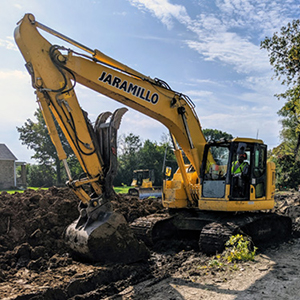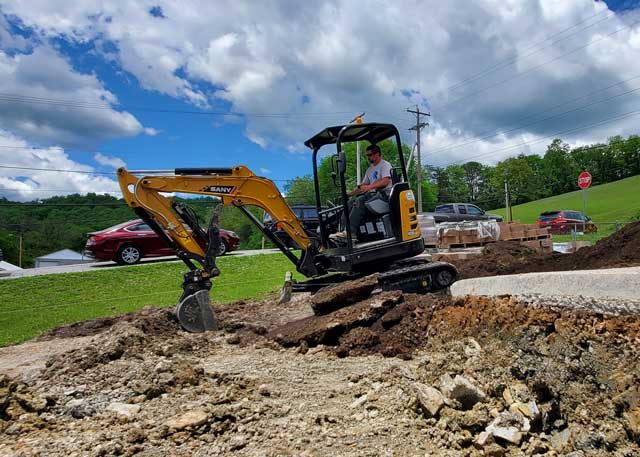Lancaster Excavation - Professional Excavation Providers in Lancaster, OH
Lancaster Excavation - Professional Excavation Providers in Lancaster, OH
Blog Article
Extensive Exploration: The Scientific Research Behind Superior Excavation Practices
The world of excavation practices is a domain where science intertwines with craftsmanship to unearth the mysteries hidden under the earth's surface area. From old hand devices to contemporary hydraulic excavators, the evolution of excavation methods has been a testament to human ingenuity and technological advancements. Nevertheless, what truly sets exceptional excavation practices apart is a deep understanding of geological concepts, paired with the application of sophisticated devices and methodologies. By discovering the scientific research behind these practices, we can reveal the tricks that lie beneath our feet and value the precision and experience that go right into every dig.
Advancement of Excavation Methods
Throughout background, the development of excavation methods has actually played an important role beforehand construction techniques and archaeological explorations. From the fundamental devices used by our forefathers to the advanced equipment employed in contemporary times, the progression of excavation techniques has actually substantially changed just how we approach different tasks.
In old times, manual work with basic tools such as shovels, wheelbarrows, and pickaxes was the key technique of excavation. This labor-intensive process limited the deepness and scope of excavations, commonly causing slow progression and restricted accessibility to particular websites. Nevertheless, as civilizations advanced, so did the methods and devices utilized for excavation.
The Industrial Revolution marked a transforming point in excavation practices with the introduction of steam-powered machinery. This innovation revolutionized the area, enabling faster and much more considerable excavations. In contemporary times, innovation plays a critical duty in excavation, with innovations like general practitioner systems, drones, and 3D scanning enhancing accuracy and performance in the area. The development of excavation methods continues to form the method we develop, discover, and comprehend the world around us.
Duty of Innovation in Excavation

The combination of advanced innovation has essentially reinvented the area of excavation, improving precision and efficiency to unprecedented levels. Among the key technological improvements that has dramatically influenced excavation practices is the use of general practitioner systems. These systems enable accurate mapping of excavation websites, making it possible for drivers to accurately situate below ground utilities and structures. In addition, the use of telematics in excavation tools has made it possible for real-time tracking of maker performance, leading to aggressive upkeep and raised operational efficiency.
In addition, the advent of 3D modeling and simulation software has streamlined the preparation process for excavation tasks. Operators and engineers can currently visualize the whole excavation process prior to beginning, maximizing and identifying possible difficulties workflow. In combination with this, the execution of drones in excavation tasks has facilitated aerial surveys, volumetric measurements, and website assessments with unequaled rate and accuracy.
Geological Principles in Excavation
An understanding of geological principles is vital for guaranteeing the architectural stability and stability of excavation websites. Geological elements play a critical function in identifying the usefulness and safety and security of excavation jobs (excavating ohio). One key geological principle to think about is the kind of soil or rock existing at the site. Different soil kinds, such as clay, sand, or crushed rock, have varying levels of security and require various excavation techniques. Cohesive dirts like clay might require additional assistance to protect against collapses, while sandy soils may be vulnerable to disintegration during excavation.
By carrying out thorough geological surveys and evaluation, designers and excavators can create strategies to mitigate threats and guarantee the successful completion of try this website excavation jobs. Ultimately, integrating geological principles into excavation methods is critical for accomplishing risk-free, effective, and lasting results.

Most Current Tools for Excavation
In the world of excavation techniques, modern advancements in try here devices have actually changed the efficiency and accuracy of excavation processes. Among the most recent tools making waves in the market is using drones furnished with innovative imaging innovation. These drones can offer comprehensive aerial surveys of excavation sites, providing real-time data on topography and potential risks. This details help in much better preparation and decision-making during the excavation procedure.
Another cutting-edge tool acquiring popularity is the implementation of 3D printing technology for creating custom-made excavation equipment. This enables the manufacturing of specialized devices that are tailored to the certain demands of a job, boosting effectiveness and lowering downtime.
Moreover, developments in products scientific research have actually brought about the development of stronger and a lot more durable excavation devices. lancaster trenching. Tungsten carbide-tipped excavator accessories, as an example, offer exceptional performance in challenging ground conditions, boosting performance on-site
Scientific research's Effect on Excavation Practices

Moreover, improvements in materials scientific research have actually brought about the production of more powerful, a lot more durable excavation devices and equipment. The usage of composite products in shovels and miners has actually boosted their performance and long life, ultimately boosting productivity on excavation sites. Additionally, scientific research study on dirt auto mechanics and geotechnical design has actually provided valuable understandings into dirt behavior, allowing excavation specialists to make educated choices relating to excavation methods and dirt stabilization strategies. On the whole, scientific research remains to drive development and improvement in excavation techniques, making excavation click over here now jobs a lot more effective, cost-efficient, and sustainable.

Conclusion
Finally, the development of excavation strategies has actually been significantly influenced by developments in technology and a deeper understanding of geological principles. The most recent tools and tools used in excavation have improved performance and accuracy in the area. The application of clinical knowledge has dramatically boosted excavation techniques, leading to a lot more efficient and sustainable methods for digging deep into various types of products.
In the realm of excavation methods, contemporary technologies in devices have actually transformed the performance and accuracy of excavation procedures. By leveraging scientific concepts, the excavation industry has actually been able to dramatically boost effectiveness, accuracy, and security in excavation processes. GPR permits excavation groups to non-invasively check and map subsurface structures, energies, and possible dangers, enabling them to plan excavation projects with greater accuracy and minimized danger of mishaps.
In addition, scientific study on dirt technicians and geotechnical engineering has provided beneficial insights right into dirt actions, allowing excavation professionals to make enlightened choices regarding excavation methods and dirt stablizing methods. Overall, science proceeds to drive development and enhancement in excavation methods, making excavation tasks much more efficient, cost-efficient, and lasting.
Report this page